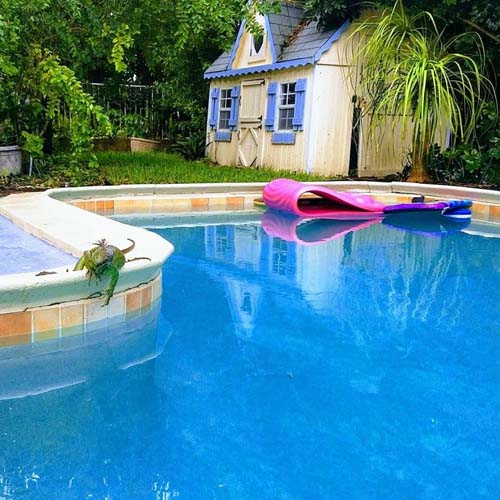Miniature green dinosaurs aren’t exactly overrunning Vero Beach, but when one of these colorful, non-native iguanas takes up residence in your yard – doing its business on the patio or devouring your ornamentals – it can seem like a bad Jurassic Park dream.
Jenna Featherstone, who lives just south of the 17th Street Bridge on the oceanside of A1A, chose to just look the other way when a 3 ½-footer became her unwelcome tenant and boldly lounged by her swimming pool.
“We just put up with it,” Featherstone wrote in a Facebook post. “I thought it may have been someone’s pet who escaped or something. Either way, I don’t bother him.”
Featherstone is probably correct that the nuisance lounge lizard either escaped from its owner’s home or was let go on purpose when it grew too large for the owner’s comfort.
While iguana populations are now well established in Miami-Dade and Broward counties and the Keys, where they have become a major nuisance, most of the animals found in Indian River County are believed to be abandoned pets – their numbers kept in check by cooler temperatures they cannot withstand.
According to the Florida Fish and Wildlife Conservation Commission, green iguanas are native to Central and South America and the eastern Caribbean, and were first spotted in Miami-Dade County in the 1960s.
The animals multiplied rapidly and there now are “many hundreds of thousands” of the scary-looking lizards enjoying a relaxed Florida lifestyle in and around Miami and Fort Lauderdale, where they cause a range of serious problems.
“Out of control iguanas infesting South Florida,” was the title of a June article in the Sun Sentinel newspaper, which reported that “packs of green iguanas are swarming seawalls, roaming yards and parks, and leaving a path of destruction and filth in their wake.
“There’s no real way to come up with a valid estimate of the number of green iguanas in Florida. But the number would be gigantic,” Richard Engeman, a biologist for the National Wildlife Research Center, told the Sun Sentinel. “You could put any number of zeros behind a number, and I would believe it.”
The Vero population had begun to increase by the early 2000s, but then Mother Nature intervened.
Indian River County Animal Control manager Jason Ogilvie says his team used to be called out to deal with rogue lizards “once or twice a week. But the 2010 [cold snap] kind of like wiped them out. The calls went down drastically . . . It’s a mild thing for us now,” with only about one call a month.
Vero Beach Animal Control Officer Scott Lee agrees that iguanas are not a big problem here at present. He has only responded to about half a dozen calls in the 2 ½ years he’s been on the job, and has caught a grand total of two.
“The last one I caught, I could tell she belonged to someone, because she was a 5-footer and I could go right up to her and pick her up,” Lee said.
Currently, he’s tracking an escapee in the Riomar Drive-Painted Bunting Lane area of the island. “Every time I get the call and I go there, it’s nowhere to be seen,” he said.
Iguanas are vegetarian, feasting on a wide variety of trees, bushes and flowers. Besides chewing up landscaping, they damage public infrastructure such as sidewalks and seawalls by digging burrows beneath them, and cause power outages by chewing through cable. In South Florida, they are the second-largest animal cause of blackouts.
They also pose a health hazard because they can transmit salmonella through their feces. On the plus side, they’re not typically aggressive towards people and usually flee when approached.
Releasing a pet iguana into the wild is not only damaging to the environment, but illegal. The FWC advises turning unwanted pets in through its Exotic Pet Amnesty Program where they will be re-homed, regardless of whether they were kept legally or illegally.
The agency’s tips for deterring iguanas and other non-native lizards from settling on your property include: Do not feed them or leave pet food outside; protect gardens with cages or screened enclosures; create a wire fence barrier along seawalls to prevent digging; and engage in humane hazing such as spraying them with a garden hose to drive them away.
If these measures don’t work, you are legally entitled to euthanize the animals humanely, or call Animal Control or a licensed wildlife trapper to remove them.
If you decide to call Animal Control, Lee says you’ll make his job easier if you don’t approach the intruder, but instead keep an eye on it from a distance. He’ll get there as soon as he can and capture it with a net.

